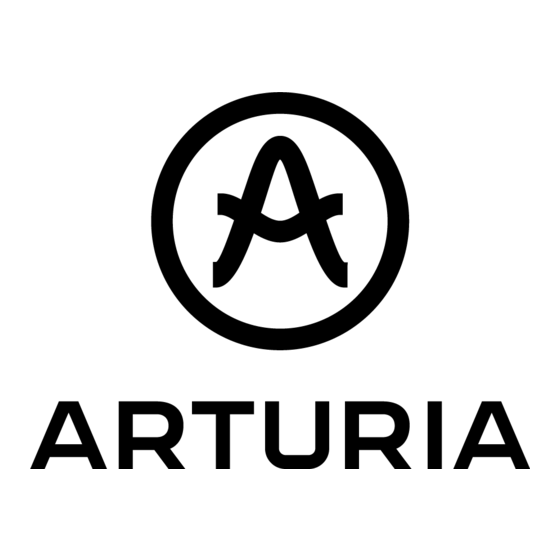
Table of Contents
Advertisement
Advertisement
Table of Contents

Summary of Contents for Arturia microbrute connection
- Page 1 MICROBRUTE CONNECTION USER'S MANUAL...
- Page 2 Information contained in this manual is subject to change without notice and does not represent a commitment on behalf of ARTURIA. The hardware unit and the software product described in this manual are provided under the terms of a license agreement or non-disclosure agreement. The license agreement specifies the terms and conditions for its lawful use.
-
Page 3: Table Of Contents
TABLE OF CONTENTS TABLE OF CONTENTS ............................3 MicroBrute Connection software......................4 Configuration Page............................5 MIDI Settings ................................5 Sequencer settings ..............................5 Play ........................................ 5 Seq Retrig....................................5 Next Sequence................................... 6 Sequence Step size .................................. 6 Step/Gate ....................................6 Module Settings ................................7 LFO Retrig....................................7 Envelope Modes .................................. -
Page 4: Microbrute Connection Software
MicroBrute Connection software Even though the MicroBrute synthesizer is analog, it comes with a software editor allowing various configuration tasks, such as: MIDI channel selection, Pitch Bend range, LFO and Envelope-triggering, Sequencer settings, and Firmware updates. -
Page 5: Configuration Page
Configuration Page MIDI Settings Receive Channel – this sets the channel that the MicroBrute will receive MIDI data on. You can choose individual channels or ALL channels. Transmit Channel - this sets the MIDI channel that the MicroBrute will send MIDI data on via USB. -
Page 6: Next Sequence
Next Sequence The Next Sequence function will determine how sequences change from one to another. The options are Instant and End of Seq. • End– The sequencer will wait until the last note of the current sequence before changing to the next sequence. •... -
Page 7: Module Settings
Module Settings LFO Retrig The LFO can be set to Freerun or Retrig modes. Freerun is the default mode. • Retrig off – In this mode the LFO will start on power up and the waveform will run continuously. This means that when you key a note, the state of the LFO can be at any point in its duty cycle. -
Page 8: Keyboard Parameters
clocking. If there is no MIDI clock present, the sequencer will play on the internal clock. If MIDI clock starts, it will change sync to MIDI clock. • Internal – Internal will select the internal Sequencer clock. In this mode, external sync is ignored. -
Page 9: Check Update
When you first power up the MicroBrute connection software, it will check the version of firmware that you have in your machine. The software will display the current version that you have. Check Update You can check the latest version that is available by clicking on the CHECK UPDATE button. -
Page 10: Sequences Page
SEQUENCES page Reset sequences This will reset all the sequences to the factory default sequences. WARNING: THIS WILL ERASE ALL YOUR INTERNAL SEQUENCES! There is no way to get them back! Save sequences Once you have made some sequences, you might want to save them for later use or to be able to send them to your computer as MIDI files that can be used in other software apps. - Page 11 the MicroBrute. When you SAVE SEQUENCES it will create a file with the extension .mbseq You can then load this file and send it to your MicroBrute. This will write over your internal sequences so make sure you save anything you don’t want to lose before loading a different bank in.
-
Page 12: Mbseq File
.mbseq file The .mbseq file is a simple text file that you can edit using a text editor. It is very easy to create your own sequences or edit them. Data Format: 1:60 60 60 60 60 60 60 60 60 60 60 60 60 60 60 60 2:60 60 60 48 60 60 60 72 60 60 60 48 60 60 72 48 3:48 60 48 60 48 60 63 51 48 60 48 60 63 51 67 55 48 60 48 60 48 60 63 51 48 60 48 60 63 51 67 61 4:60 60 60 60 60 60 57 59 60 60 60 59 60 60 60 60 60 60 62 59 60 62 64 67 69... -
Page 13: Changing Parameters Via Midi Ccs
Changing parameters via MIDI CCs The MicroBrute allows you simple access to all the parameters found in the editor via easy to use MIDI CCs. When parameters are changed using CCs, changes will be lost after a restart. To write changes to internal memory you have to use the editor. Parameter MIDI CC Value... -
Page 14: No Liability For Consequential Damages
6.1 No liability for consequential damages Neither ARTURIA nor anyone else involved in the creation, production, or delivery of this product shall be liable for any direct, indirect, consequential, or incidental damages arising out of the use of, or inability to use this product (including without limitation, damages for loss of business profits, business interruption, loss of business information and the like) even if ARTURIA was previously advised of the possibility of such damages. - Page 15 6.4 Europe 89/336/EEC.















Need help?
Do you have a question about the microbrute connection and is the answer not in the manual?
Questions and answers